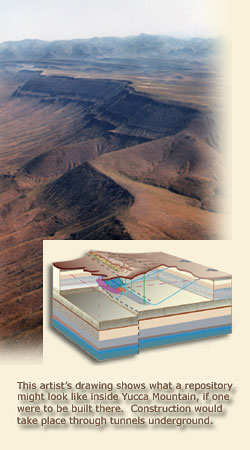 |
 |

Overview: Yucca Mountain Project
Some nuclear materials used for national defense create waste. This waste is called high-level radioactive waste. These highly radioactive materials must be protected so they won’t harm people or the environment. What should we do with radioactive waste to protect people and the environment? Scientists have studied different ways to dispose of this radioactive material. Currently, it is stored at government sites and at the power plants where it is made. However, a permanent disposal place is needed. Most scientists around the world agree that the best place to put this radioactive material is in a facility deep underground. This type of facility is called a geologic repository. The U.S. Department of Energy (DOE) has studied Yucca Mountain for more than two decades. In 2002, the secretary of energy and then the president recommended the site as suitable for a geologic repository. Congress subsequently supported this recommendation, officially designating Yucca Mountain for a proposed repository. Now the DOE can submit a license application to the Nuclear Regulatory Commission, which has three to four years to decide whether to grant a license to construct a repository. Why Yucca Mountain? Yucca Mountain is about 100 miles northwest of Las Vegas, Nevada, on land owned by the federal government. No one lives on Yucca Mountain. The area has a very dry climate — receiving a combined average of about 7.5 inches of precipitation per year. Approximately 95% of this total either runs off, evaporates, or is taken up by the desert vegetation. Yucca Mountain has a very deep water table. If a repository is built at Yucca Mountain, it would be located about 1,000 feet below the surface and 1,000 feet above the water table. So any water that does not run off or evaporate at the surface would have to move down nearly 1,000 feet before reaching the repository and then another 1,000 feet before it reached the water table. The dry climate is an important feature because water is the primary way by which radioactive material could move from a repository. How would a repository work? The basic idea of geologic disposal is to place carefully packaged radioactive materials in tunnels deep underground. This method relies on a series of barriers that prevent or slow the movement of radioactive materials from a repository. These barriers include natural ones, such as thick unsaturated rock, and man-made, or engineered, ones. These barriers also would greatly reduce the total amount of any radioactivity that could eventually reach the water table where people might pump it from the ground and use it. The current design for the potential repository calls for spent nuclear fuel and high-level radioactive waste to travel to Yucca Mountain by truck or rail in specially designed, shielded shipping containers. Once these materials arrive at the repository, they would be removed from the shipping containers and placed in double-layered, corrosion-resistant packages for burying underground. Special rail cars would carry them underground, and remotely controlled equipment would place them on supports in an underground tunnel. Once the materials are placed in the repository, scientists would continue to check that everything is working the way it should during the performance confirmation period. Who will determine if a repository is built at Yucca Mountain? Before the DOE could construct a geologic repository and begin waste emplacement, the Department must submit a license application, go through a multi-year review and public hearing process, and then receive a construction authorization from the Nuclear Regulatory Commission (NRC). The hearing process would focus on public health and safety. Along with the review process, the hearing process is expected to take a minimum of three years after the DOE submits a license application. If the DOE receives a construction authorization, it would have to complete initial construction, and apply for and receive a license from the NRC before any waste could be received or emplaced. This includes demonstrating to the NRC that there is a reasonable expectation a repository designed for the Yucca Mountain site could protect health and safety for 10,000 years after the repository is closed. |
||
Yucca Mountain Project

